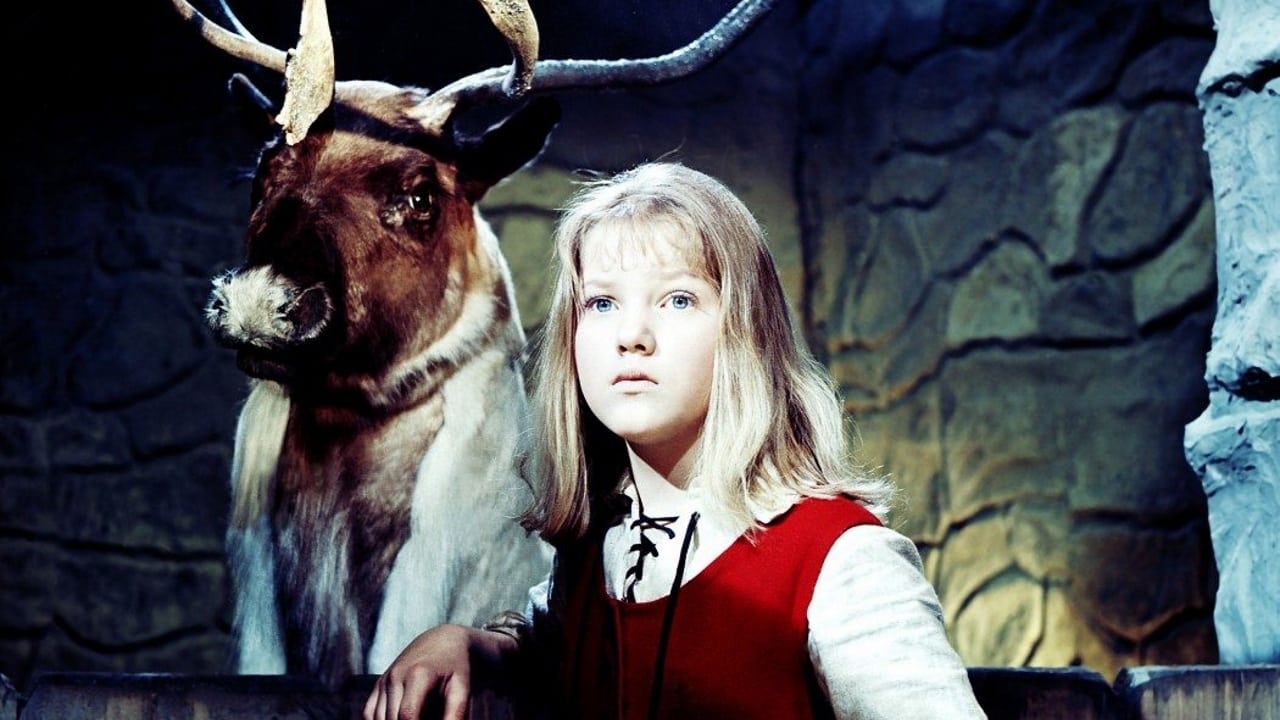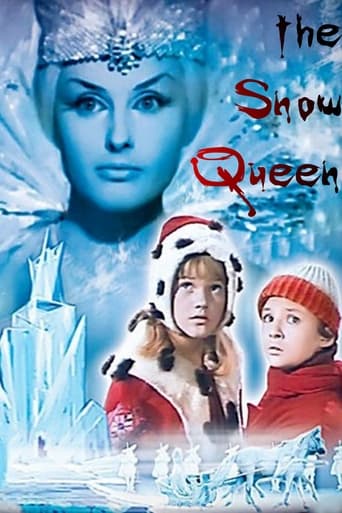

The Worst Film Ever
... View Moreridiculous rating
... View MoreJust perfect...
... View MoreInstant Favorite.
... View MoreThe Snow Queen in my mind is one of Hans Christian Andersen's best stories. Anybody who loves the story, and as long as they don't mind the omissions and the changes, will love this film. As far as 1960s Russian film adaptations of fairy tales go, The Snow Queen is not quite as good as The Tale of Tsar Sultan and Snow Maiden but it still shares many of the qualities that made those two films as good as they were. It is a good-looking film, though some of the special effects do look as though they were made on a limited budget, with handsome photography and costumes and sets that give a real magical feel. The film genuinely feels like a fairy-tale but at the same time there is something endearingly Russian about which I loved. The music score is beautiful, haunting and dramatic, and while the story is not entirely faithful to the original fairy tale it still has its charm and magic and told swiftly and coherently. The image of the Snow Queen watching through the window is still one that haunts me, and the silhouette of the Narrator is very striking and makes you want to keep on watching it to the end. The acting fits very well within the story, Elena Proklova is a moving Gerda and one that allows her character to grow. But the best performances come from Evgeni Leonov's King and especially Natalya Kilmova's chilling Snow Queen.All in all, very well done indeed. 9/10 Bethany Cox
... View MoreInterestingly just like in 'Kingdom of Crooked Mirrors' (1964) - another Russian fairy tale movie I just watched yesterday - the king isn't the brightest bulb in the box and secretly is under the command of the kingdom's richest man, a capitalist through and through he made it big as a businessman by selling ice and as is usually the case with people who have handled ice a lot he is as pale as Dita von Teese, his body temperature is 34.2°C and consequently is heartless and spews "Nonsense!" a lot when other people talk about feelings.He's the story's main villain. Although he makes a lot of trouble for the main character - a girl on the quest to save her brother who has a cold heart after he kissed the snow queen (Nyzzzz!) and is now in her hands - he eventually lacks the courage, the willpower and the strength to ever finish anything he started because he comes to a halt as soon as he is confronted with an obstacle that he can't move out of the way by "throwing money at it" (=figuratively speaking...I suppose one has to make that clear when talking about a fairy tale movie). In one scene he negotiates with a group of thieves and when the head of the thieves asks if they can trust him he puts himself on the same level as thieves by saying: "Nonsense! We are both businesspeople." The message is clear, capitalists are criminals.The movie starts off with a teller of fairy tales walking the streets who through voice-over explains that he will not only tell but even show us a fairy tale in which he puts himself in. Although not one of the most prominent characters in the tale he secretly makes himself the hero because his character repeatedly saves the day. The "good guys" win their battles almost effortlessly and eventually it is VERY easy for the girl to bring her brother back home and to warm his cold heart again (which takes her two minutes of chit-chat with him).Visually it isn't too spectacular except for the titular Snow Queen whose appearance is dashing while her persona is positively icy and her impressive ice palace which you only get to see for one scene towards the end doesn't need to shy away from a comparison with "Superman"s Krypton sets.
... View MoreThere are two Russian adaptations of this fairy tale by Hans Christian Andersen, made within less than ten years, the animated version of 1957 and this live-action movie of 1966. The first version is nearer to the original tale most of the time. In the second version, some chapters have been left out. In the fourth chapter, much has been changed and much was added that is not in the tale. This version is apparently based on an adaptation (for the stage) by Yevgeni Shvarts (or "Yevgheny Schwartz"), which probably explains the higher number of changes.In both versions, a narrator has been added, in this version the fairy story teller Andersen, played by Valeri Nikitenko, in the older version a character from another tale by Hans Christian Andersen, Ole Luk-Oie. The end has also been changed more or less in both adaptations, and both leave out those parts of the story that (directly) have to do with Christianity, for example Gerda's prayer and the song lines "Roses bloom and cease to be / But we shall the Christ-child see". This is probably due to the fact that Russia was a communist country back then. But the core and the basic message of the story are there in both versions: Kay is robbed of his feelings and abducted by the Snow Queen to her palace in the far north. But without feelings a human being isn't really human any more. Gerda misses her best friend Kay and has to try to get to the Queen's palace and make his heart of ice become warm again. At this point the live-action version is nearer to the original than the animated version, which leaves out the Snow Queen's promise to Kay: if in "the icy game of reason" he manages to form the word "eternity" out of some pieces of ice "you shall be your own master, and I will give you the whole world and a new pair of skates". The outcome of this game is probably an important part of the message of the story - it probably means that pure reason, cold logic, can not lead to eternity - only love can.The adaptation for the screen makes a good impression overall, for example the actors' performances and the music by Nadezhda Simonyan. The special effects, though, are not very good, for example they inserted animated shots (which were not taken from the '57 version) in some sequences that would have been difficult to do as live-action.There are lots of adaptations of this story, animated and live-action, filmed stage adaptations, episodes from fairy tale series. I have seen one when I was a child, but which one was it? This one, or perhaps another one? It's too long ago to remember. But I remember that the story really impressed me. The Snow Queen gave me a proper scare. A woman who can turn a small boy's heart into a lump of ice. How easily one can become immersed in the imaginary world of a movie as a child. Everything seems to be practically as real as reality. Even if the special effects are bad. As an adult, one is not - unfortunately? luckily? - as easily impressed by a movie. But the Snow Queen in this adaptation, played by Natalya Klimova, is I think awe-inspiring enough for today's children also to be able to have an exciting time watching this movie. As to this I think the scene in which the Snow Queen is looking at Kay and Gerda through the window is particularly well done. Her white over-sized face makes her look like a menacing giant and her appearing is accompanied by dramatic music.Conclusion: I think it wouldn't have been a bad idea to stay closer to the original tale, and, as I've mentioned before, the special effects could have been better. And the robber girl's cute animated rabbits in the '57 version, which I haven't mentioned before, are of course missing from this version, there's only a female robber chief who looks like Brezhnev. Still I think that it is an all in all good adaptation of the fairy tale that will probably be fun to watch for children and that grown up fans of fairy tale movies will probably also like. Fans of animated movies will probably prefer the '57 version. I think it is about as good as the live-action version (7 out of 10 points for each). But the later version also includes the Snow Queen's promise to Kay (see above) and I liked the music better, so I think it's slightly preferable. Dosvidanye.
... View MoreThis pleasant Soviet fairy tale was fun to watch, and interesting in its use of special effects (up to splicing in some seconds of cartoon, when real action would have been too difficult, especially with flying animals). After I got it with SuperIllu magazine two days ago, I watched it twice, and enjoyed the second time around even more.One might say this is a story about strong women. Starting from Grandmother who runs the household well, Gerda who sets out heroically to rescue her little brother Kai, the princess who clearly dominates her husband as well as her father the King, the impressive robber queen and her very independent daughter.. up to the titular Snow Queen of course - they all command the scenes they are in, while men appear in weaker, sometimes clownish roles (my favorite was the Hitler caricature who lost all his clothes and boots in gambling). I could see no "communist propaganda" in this charming film. But if it contributed to more self-consciousness of girls and women in its time, I can only applaud - as a 53yo man who watched this 43 years after it came out. I enjoyed it and recommend it, if you like Russian fantasy movies, or are just curious about films from elsewhere than Hollywood.
... View More